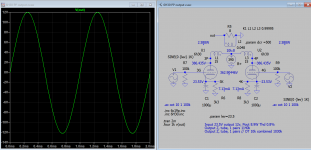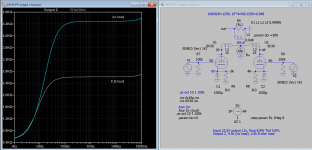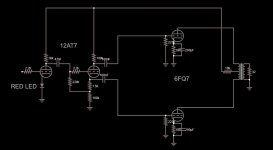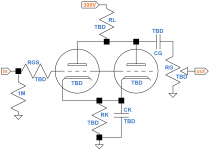I've been prototyping headphone amplifiers for some time now, using tubes I have on hand from TV pulls and whatnot. I currently have a more-or-less textbook 6FQ7 push-pull triode setup with a 12AT7 preamp and phase inverter. It's fed into a 10k:600 OPT and sounds good to my ear. B+ of 390v. Plate voltages and current are all in spec. I'm curious about its actual output impedance though. That OPT is almost certainly not ideal, the 600ohm secondary notwithstanding. I've attempted to learn how to figure it out, but so far it has eluded me. It'll get plenty loud for 98% of music out there, but I would appreciate a tad more headroom in case it's ever needed. I was looking online and found a good bit of praise for the 6H30. It has overall higher plate dissipation at 8W for both plates combined. The 6FQ7 is 4W each or 5.7W total. I've also read that the 6H30 has considerably lower output impedance. That being said, I have no idea what said impedance would be with two 6H30 triodes in PP. Can someone clue me in? Is it worth buying $70 worth of new tubes or should I look into a different OPT for what I currently have?
The 'olde fashioned way' is not quite right for this. As in load it until output voltage is halved; the reflected load changes the gain, and this change is a reduction.
A rough idea is ratio 2x the plate resistance by the load, and multiply that by the nominal secondary load. This for Class A, and it looks like your voltage is a wee bit high for that across the board.
cheers,
Douglas
A rough idea is ratio 2x the plate resistance by the load, and multiply that by the nominal secondary load. This for Class A, and it looks like your voltage is a wee bit high for that across the board.
cheers,
Douglas
See if you find any useful data from this sim based on your configs. How many output watts you're getting now? With 6c19p gets only 2 Watts more, but with a lower Z OT, output maybe increased, as now 10k/4.5k=2.2 rp:OT ratio.
Attachments
The ECC99 is cheaper and results can be quite good. If one wants enough power and low output impedance can use 2x ECC99 per channel, which means parallel push-pull. This can give easily 1-1.5W in pure class A operation with lower plate voltage around 250V (also making power supply cheaper) and low output impedance around 150R using the 10K:600R transformer. Each tube can work at about 18 mA and this will make plate dissipation 2.25W per triode against 3.5W max recommended with reasonably good life.
The 6H30 can give similar output impedance only using 1 triode per channel but not the same power otherwise won't last long if will work close to max power dissipation....this could easily result in being more expensive (i.e. 6H30 life is less than 50% of ECC99 life).
The 6H30 can give similar output impedance only using 1 triode per channel but not the same power otherwise won't last long if will work close to max power dissipation....this could easily result in being more expensive (i.e. 6H30 life is less than 50% of ECC99 life).
2 6P1P (or 6V6 etc) triode strapped per channel would work nicely into 10k and give nice linear results with almost 2W of power.
yes and the Russian version also looks cool with its black coated glass. I have these and they are more rugged than most common 6V6s. Can take up to 420V plate voltage: up to 30W "clean" for guitar amp and 20W for HiFi from a single pair in PP (pentode).
Thanks for all the replies. The headphones I have now are 32 ohm, I think. They're just a pair of cheapos. I'm planning on getting a pair of Grados though, and I think they're also 32 ohm. The power supply I'm running at the moment is a 170v transformer feeding a 4x8 doubler from a different design I have been playing with. I have another vintage transformer from an old radio that puts out 700-0-700, 5v, 6.3v. That would be more in line with what I'd need, would it not? It drove a single ended 6V6GT in a 7-tube tri-band console radio so I would think it'd be able to supply the current for a small headphone amp.
I'd be scared I'd blow up my headphones with something as powerful as a 6V6, even triode strapped. I already blew up one pair with my last design. It used 6GC5s and sounded great...until it didn't. They were cheap at least, but I would be sweating bullets over the thought of plugging a brand new $300 pair of Grados into that bad boy.
I've included a schematic of what I've got now. I drew this from memory, but I think I got the values correct. Now, by "parallel" do you mean something more akin to the image with the white background?
I'd be scared I'd blow up my headphones with something as powerful as a 6V6, even triode strapped. I already blew up one pair with my last design. It used 6GC5s and sounded great...until it didn't. They were cheap at least, but I would be sweating bullets over the thought of plugging a brand new $300 pair of Grados into that bad boy.
I've included a schematic of what I've got now. I drew this from memory, but I think I got the values correct. Now, by "parallel" do you mean something more akin to the image with the white background?
Attachments
Roger Modjeski's RM10 is up to 35W from a pair of EL84 PP at 700V Va, 350V VG2, 15+15mA Ia, 13K Raa. I think the 6V6 can take much higher Va as long as Vg2 is kept well below runaway threshold.... more rugged than most common 6V6s. Can take up to 420V plate voltage: up to 30W "clean" for guitar amp and 20W for HiFi from a single pair in PP (pentode).
I would never play an electric guitar before a paid audience that used a guitar amplifier that was pushed to the limit, unless I also brought a backup amp that was more conservatively designed and reliable.
Push the only amp you have to the limit, break it . . . and incur the wrath of the crowd.
Push the only amp you have to the limit, break it . . . and incur the wrath of the crowd.
Then your tubes are working into 5K and not 10K. You have to either design the amplifier taking into account 5K load (6V6 or other small power tubes are surely more suited than signal tubes like 6FQ7, 6H30 and ECC99 if you also looking for some power) or change transformer to one with secondary for 32R load.Thanks for all the replies. The headphones I have now are 32 ohm, I think. They're just a pair of cheapos. I'm planning on getting a pair of Grados though, and I think they're also 32 ohm.
Third option, if you want to use tubes like 6FQ7 with higher plate resistance is that you look for a headphone output transformer with primary impedance in the 15K range for parallel push-pull or 30K for PP, in both cases with 32R secondary. Multiple secondary choice is also a good thing in case you want to change headphones with different impedance.
If 6H30s were really an option then you could invest in output transformers. Tubes have limited life, transformers are forever and if want to re-sell will get good money back if good quality.
I'd be scared I'd blow up my headphones with something as powerful as a 6V6, even triode strapped. I already blew up one pair with my last design. It used 6GC5s and sounded great...until it didn't. They were cheap at least, but I would be sweating bullets over the thought of plugging a brand new $300 pair of Grados into that bad boy.
You don't need to be scared. If you don't feed the output tube it will not return great power.
The 6V6 for example in triode mode is already approx. half efficient respect to tetrode. Easier way to control output power if you want to use that input stage is reduce plate voltage. Say 200V plate voltage max. If this might not be enough for the 12AT7 can use the 6DJ8 which can run linearly at plate voltage as low as 80-90V without special requirements.
Also consider that triode wired 6V6 has less gain than 6FQ7, ECC99 and 6H30. Half or less than half gain, normally.
The 6V6 is a very flexible tube and is used with success also as line preamplifier. In such application, triode connected, can run even at 24-30V plate voltage with 10-15K load.....
You could also do the contrary of what you are doing now: use a common output transformer with 16R secondary with 32R load. This will double your primary load. If the transformer is decent quality inductance will be more than enough.
For example you could try with the EDCOR GXPP-12K with 16R secondary.
Using 32R headphone you will get 24K primary impedance and can use just 1 6FQ7 or ECC99 per channel.
EDCOR - GXPP10-12K
Cost is $46 at the moment. see what you pay for good selected 6H30.....
For example you could try with the EDCOR GXPP-12K with 16R secondary.
Using 32R headphone you will get 24K primary impedance and can use just 1 6FQ7 or ECC99 per channel.
EDCOR - GXPP10-12K
Cost is $46 at the moment. see what you pay for good selected 6H30.....
Since the load is reflected, If your headphones are 32R, and your OPT is 10k:600, you are loading your tubes with about 500R a-a load, no?
yes...I wrote 5K but that was a mistake....I was thinking about 64R for some reason
- Status
- This old topic is closed. If you want to reopen this topic, contact a moderator using the "Report Post" button.
- Home
- Amplifiers
- Tubes / Valves
- PP Triode Choice & Output Impedance




 Duplicate threads merged.
Duplicate threads merged.